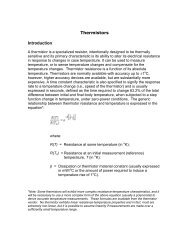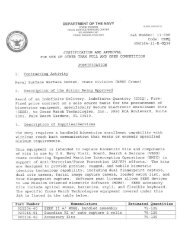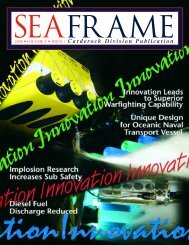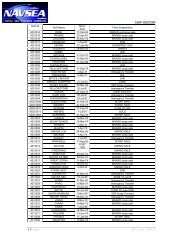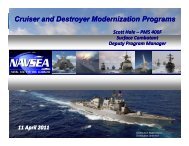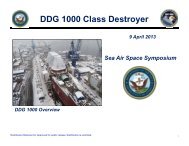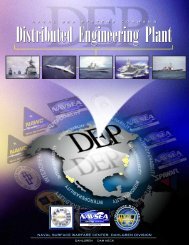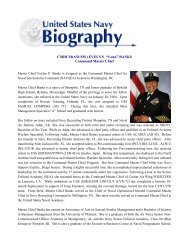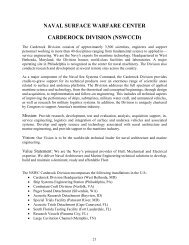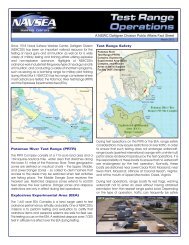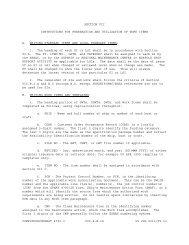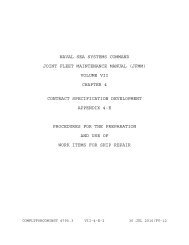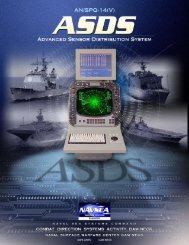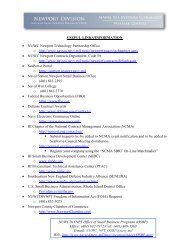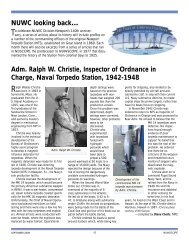Volume 6, Issue 1 - Naval Sea Systems Command - The US Navy
Volume 6, Issue 1 - Naval Sea Systems Command - The US Navy
Volume 6, Issue 1 - Naval Sea Systems Command - The US Navy
Create successful ePaper yourself
Turn your PDF publications into a flip-book with our unique Google optimized e-Paper software.
SEAFRAME<br />
22<br />
Core equities<br />
ACCELERATED<br />
INSERTION OF<br />
MATERIALS<br />
Replacing Iterative Testing with<br />
Software-Based Predictive Tools<br />
By<br />
William<br />
Palmer<br />
When dealing with materials in a<br />
shipboard environment, ship designers have to<br />
know material qualities such as strength, ductility,<br />
toughness, and fatigue and corrosion resistance<br />
before they can be used on a ship. <strong>Naval</strong> Surface<br />
Warfare Center, Carderock Division (NSWCCD)<br />
researchers would like to take advantage of new metal alloy<br />
combinations, but are up against a long design cycle in getting<br />
to know how the complex interplay between new materials<br />
and fabrication processes affects these properties. It can take<br />
years for a new alloy to go through the design and testing<br />
process to become qualified as a ship construction material and<br />
enter into production.<br />
In an earlier Defense Advanced Research<br />
Projects Agency (DARPA) sponsored program, General<br />
Electric, maker of aircraft turbine engine components, used<br />
commercially-available software-based computational tools<br />
which could show metallurgists how an alloy’s properties<br />
could change when its composition and processing were<br />
changed. <strong>The</strong>ir cycle for jet engine turbine blade design and<br />
insertion was reduced from 12 years down to six. Because of<br />
this success, Dr. Julie Christodoulou of the Office of <strong>Naval</strong><br />
Research (ONR) approached Carderock to develop a similar<br />
system for naval materials. <strong>The</strong> <strong>Navy</strong>’s accelerated insertion<br />
of materials (AIM) program was thus born about four years<br />
ago, and Carderock materials engineers turned back to the<br />
aircraft industry as their starting point. <strong>The</strong> Carderock team,<br />
led by materials researcher Dr. David Forrest, is using GE’s<br />
architecture as a template to simulate the microstructural<br />
evolution of <strong>Naval</strong> alloys during production, with the similar<br />
goal of reducing iterative testing of alloys, and cutting <strong>Naval</strong><br />
alloy design and qualification cycles. <strong>The</strong> effort is guided<br />
and funded by ONR, with support from NSWCCD and<br />
Technology Stewardship funding.<br />
Since Carderock initially had no team and no<br />
organized resources in place, Forrest had to build a program<br />
from the ground up. High-performance computing resources<br />
were available at the on-site SEATECH computing center,<br />
and total investments of about $200,000 were made in<br />
software modeling packages and software maintenance.<br />
Forrest also had help from Dr. Dan Backman, a retired GE<br />
program manager and renowned expert in the field, who had<br />
set up the AIM program for GE.<br />
While a number of software modeling and analysis<br />
tools could simulate the extrusion process or calculate<br />
microstructural features, an essential feature of an AIM<br />
system is the integration and automation of these tools.<br />
`<strong>The</strong>y must be able to “talk” to each other despite the lack<br />
of a common format for input and output, because the<br />
software routines were written to work independently, not<br />
in concert with each other. Fortunately, iSight, a software<br />
package capable of harmonizing the formats, had been used<br />
successfully in the DARPA-funded work and was available.<br />
Once the means of simulating the processing was<br />
in place, researchers turned their attention to an extrusion<br />
process used by United Kingdom vendor Sapa Profiles,<br />
Ltd., to produce an AA6082 aluminum alloy-based sidewall<br />
panel with integral stiffeners for the second Littoral Combat<br />
Ship (LCS) design. Researchers wanted to use this process<br />
as a target with which to validate the accuracy of their alloy<br />
modeling programs, because the programs would have<br />
to model a deformation, which in reality occurs when an alloy<br />
ingot is pushed through a die (much like playdough through<br />
a form) to shape the LCS panel. Also, engineers wanted to<br />
accurately model the heat treatment process. Magnesium<br />
silicide nanoparticles come out during heat treatment to<br />
strengthen the alloy, and engineers found it necessary to<br />
model the number and size distribution of the particles in<br />
order to predict the strength of the material.



